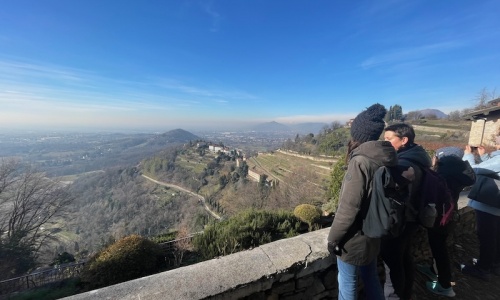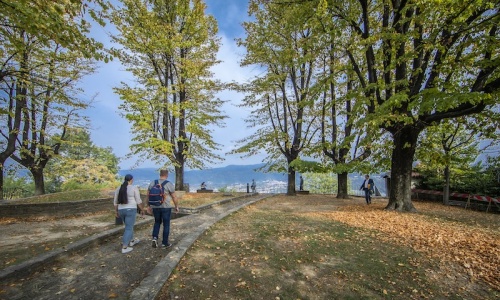This route offers a peaceful walk with gentle inclines and various panoramic viewpoints over the city and surrounding hills. The walk begins at Porta Sant'Alessandro, near the San Vigilio funicular. You can reach Porta Sant'Alessandro by taking urban bus number 1 and getting off at the last stop, Colle Aperto. Although the route is easy, be careful if you are walking with small children, as some sections are exposed.

After passing Porta Sant'Alessandro, you will immediately find the San Vigilio funicular on your right, built in 1912. In just a few minutes, it will take you to the top of San Vigilio Hill, offering a beautiful view of the hills and plains. Upon exiting the funicular, first turn left and then right, walking along Via San Vigilio, which is shared with cars. Walk for about 300 meters uphill until you reach Via Vetta on the left.
Continue along this paved road with views of the green hills, and then turn right onto Via Monte Bastia, followed by Via Orsarola, and finally Via Ciaregotto. The latter is a green path without barriers, so be careful as you walk.
After passing Porta Sant'Alessandro, you will immediately find the San Vigilio funicular on your right, built in 1912. In just a few minutes, it will take you to the top of San Vigilio Hill, offering a beautiful view of the hills and plains. Upon exiting the funicular, first turn left and then right, walking along Via San Vigilio, which is shared with cars. Walk for about 300 meters uphill until you reach Via Vetta on the left.
Continue along this paved road with views of the green hills, and then turn right onto Via Monte Bastia, followed by Via Orsarola, and finally Via Ciaregotto. The latter is a green path without barriers, so be careful as you walk.

The second kilometer descends on asphalt and leads to the tricolor flag flying above the Casa degli Alpini. From here, turn left onto Via Colle dei Roccoli to start the return journey. You will walk past typical stone walls and houses, eventually reaching the small Church of S. Sebastiano. Before continuing left along Via San Sebastiano, it is worth visiting the interior of the church, which is rich in frescoes dating back to the 14th and 15th centuries.
Resume the walk, and when the road curves right, you will come across the ancient Fontana dell'Acqua Morta, dating back to the 12th century and connected to the Sudorno or San Vigilio aqueduct, one of the main aqueducts that collected water from the Acqua Morta and Gavazzolo springs. You will notice traces of this conduit in the medieval fountains along Via San Sebastiano. Continue along the rolling terrain typical of the hilly area, which will eventually bring you to a beautiful gate on the left, marking the entrance to the garden of Villa Elena.
The second kilometer descends on asphalt and leads to the tricolor flag flying above the Casa degli Alpini. From here, turn left onto Via Colle dei Roccoli to start the return journey. You will walk past typical stone walls and houses, eventually reaching the small Church of S. Sebastiano. Before continuing left along Via San Sebastiano, it is worth visiting the interior of the church, which is rich in frescoes dating back to the 14th and 15th centuries.
Resume the walk, and when the road curves right, you will come across the ancient Fontana dell'Acqua Morta, dating back to the 12th century and connected to the Sudorno or San Vigilio aqueduct, one of the main aqueducts that collected water from the Acqua Morta and Gavazzolo springs. You will notice traces of this conduit in the medieval fountains along Via San Sebastiano. Continue along the rolling terrain typical of the hilly area, which will eventually bring you to a beautiful gate on the left, marking the entrance to the garden of Villa Elena.